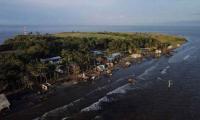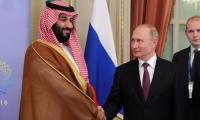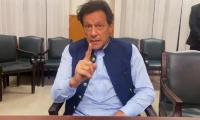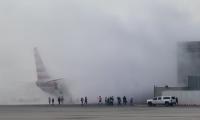As Pakistan approaches the much-awaited general elections next month, all eyes are on Punjab, which stands out as a crucial battleground in the coming elections.
The province has 141 of the 266 in the National Assembly and will see almost all of the country's major political parties vie for these seats.
History has it that political parties that have established a stronghold in Punjab have managed to form a government in the centre as well, mainly because of the large number of seats in the NA. Parties that can navigate the complexities of Punjab’s political landscape are well-positioned to lead the nation.
Given the history and the calculations, is it possible for a political party to form a government in the centre despite losing in Punjab? What role does Punjab play in the general elections?
A look at history may be instructive here.
In the 2018 elections, the PTI emerged as the largest party in Punjab with 66 seats while the PML-N became the second-largest party with 64 seats. Meanwhile, the PPP-P only managed to bag six seats in the province. The PTI, with a majority of 115 NA seats, managed to form a government in the centre in the previous general elections.
The party won 46.8% (141) of the total general seats in Punjab and PML-N 45.3% while the PPP-P was just 4.2% in the 2018 elections.
In 2013, the PML-N topped the electoral race by winning the major number of NA seats — 116 — from Punjab while the PTI could only get its hands on eight and the PPP-P on two seats.
The PML-N won the majority of 78.3% of the total general seats of Punjab — 148 — in NA with PTI just a meagre of 5.4% and PPP-P 1.3%.
The 2008 elections took place just a few days after Benazir Bhutto’s death and were predictably swept by the Zardari-led PPP-P even though it remained the second-largest party in Punjab after PML-N, considering the number of seats.
The PPP-P bagged 45 seats in Punjab, the PML-N won the majority with 63 seats while the PML-Q clinched 27 seats. However, the Zardari-led party, despite losing the majority in Punjab, formed a coalition at the centre by forming alliances in other provinces.
The PML-N had also bagged the most amount seats, which is 42.5% of the total general seats in Punjab. Meanwhile, the PPP-P won 30.4% and PML-Q 18.2%.
Speaking about the importance of Punjab for parties wanting to form a government at the centre, journalist Majid Nizami tells Geo.tv that parties need to win a significant number of seats — 40 or 50 — in the province.
However, parties can also form a coalition with others like the PPP-P did in 2008 by forming alliances in Khyber Pakhtunkhwa, Sindh and Balochistan even after PML-N won in Punjab, he added.
According to journalist Benazir, any political party looking to take a majority in the parliament would need to rack up a considerable number of seats in Punjab as it held importance electorally.
Ahmed Bilal Mehboob, president of the Pakistan Institute of Legislative Development and Transparency (PILDAT), urged that nothing could be ruled out in politics as with the extremely split mandate being predicted, a coalition could be a strong possibility. However, he added, that this is never good for political stability.
“Centre-province tensions mar progress as political parties think of the political gains rather than the general good of the people,” he observed.
Journalist Haroon Rashid called this a “problematic arrangement” adding Punjab could create a lot of problems for the federal government.
Experts also believe that the PTI does not have a level playing field as their party founder is incarcerated and unable to contest the polls.
Nizami said that the public sentiment was inclined towards the PTI, but the situation was still unclear whether it would convert into votes on election day. According to him, “If there is no fear of violence from the state, then people may turn up to vote. Otherwise, the current situation in which people are getting arrested while others are in jail then this factor can also scare the voters."
Rashid, on the other hand, said: “Since the PTI doesn't seem to have a level playing field, it seems the PML-N will be the second-best possibility”, adding that he sees a coalition ruling in Punjab.
The PILDAT president said that the PML-N would be in a “better position” to gain the largest number of seats in the NA and PA if the current scenario continued. "There hasn’t been a level playing field in the past and so is the case now but whatever the situation on the ground, PML-N seems to be getting the maximum number of seats," he added.
What are the various factors that will determine the voters’ choice in the elections. According to Nizami, “There are different factors, but first of all, the voters think about the development of their cities as to which [party] has played a major role in it. The second factor is the election campaign and which political party is in the opposition and which is facing political victimisation like PTI these days so the voters also cast their votes based on their sentiments."
Meanwhile, PILDAT's president said that the factors that will dominate the coming elections will be how the parties “portray themselves as victims of excesses by the government and establishment and how successfully they portray their opponents as cheats, thieves, people who have strangled public money”.
“Anti-establishment [sentiment] will also be a selling point in the coming elections. It will not be policies, unfortunately, or issues. It will be just very effectively communicating your victimhood and the aggression and wrongness of the others,” he added.
Journalist Benazir Shah said the themes that could influence voters’ choice include inflation and the role of the military in Pakistan’s politics.
Speaking about the Istehkam-e-Pakistan Party’s (IPP) impact on the PTI in the upcoming polls, Nizami said that the Jahangir Tareen-led party would not influence the PTI as it was a group of electables with solid votes.
Bilal said the IPP would not have a great impact on elections or the PTI as the members of the party have deserted the PTI and don’t hold any personal position.
“They won an election and had a political position because of Imran Khan. Now that they are no more with him, I do not see them having any political weight,” he claimed.
On the other hand, Rashid said that the IPP was bound to cause some political dent in the PTI with its expertise in getting electables to its side.
“The IPP’s agenda aligns with that of the establishment so it can get some support from it,” said Rashid.
Meanwhile, the voter turnout in these elections is expected to be low, according to Nizami, since it depends on political campaigning, rallies and political mobilisation.
Rashid, on the other hand, said: “If PTI voters come out in large numbers and get counted fairly we may have better turnout, but this seems very difficult to achieve because of several obvious reasons”.
He added that there would be fewer voters at the polling stations on February 8 if PTI voters were taken out of the equation.
The PILDAT president said that the voter turnout could be decent if the PTI decided to mobilise its voters despite the current situation. However, he added that it might not still exceed the 2013 and 2018 elections.
The voter turnout in Punjab in 2008 was the lowest at 48% while the turnout in 2013 and 2018 was 60% and 56.8%, respectively.
The writer is a Geo.tv staffer.
Opposition leader Omar Ayub joined JIT probe, sources said on Thursday
Residents said gas supply to some areas, including Rustam Town has been suspended
Heavy firing reported between law enforcement agencies and dacoits
District Bar Association Khairpur suspended court proceedings and demanded arrest of culprits
Both Airtel and Jio deals are conditional upon Starlink obtaining govt approval to begin operations in country
Article 8 of Constitution allows exemption from fundamental rights







